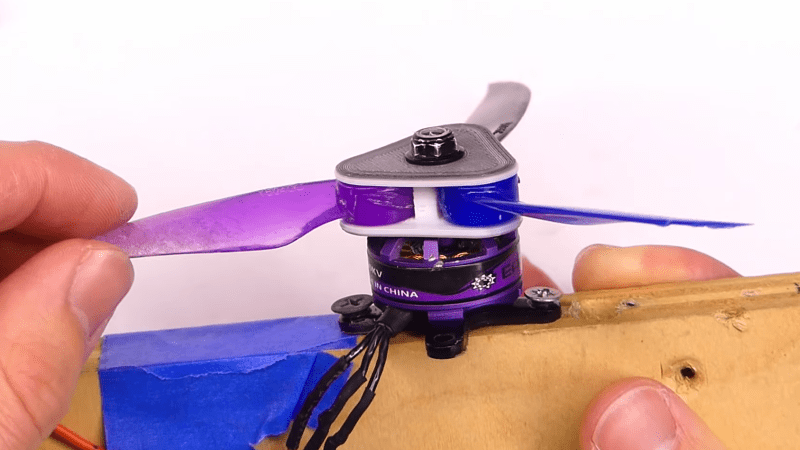If you’ve ever flown or watched anyone fly a racing drone for any length of time, you know that crashes are just part of the game and propellers are consumables. [Adam] knows this all to well, decided to experiment with combining multiple broken propellers into one with a 3D printed hub.
A damaged propeller will often have one blade with no damage, still attached to the hub. [Adam] trimmed the damaged parts of a few broken props, and set about designing a 3D printed hub to attach the loose blades together. The hubs were designed let the individual blades to move, and folding out as the motors spin up, similar to the props on many photography drones.
Once [Adam] had the fit of the hubs dialed in, he mounted a motor on a piece of wood and put the reborn propellers through their paces. A few hubs failed in the process, which allowed [Adam] to identify weak points and optimise the design. This sort of rapid testing is what 3D printing truly excels at, allowing test multiple designs quickly instead of spending hours in CAD trying to foresee all the possible problems.
He then built a test drone from parts he had lying around and proceeded with careful flight testing. The hubs were thicker than standard propellers so it limited [Adams] motor choices to ones with longer shafts. Flight testing went surprisingly well, with a hub only failing after [Adam] changed the battery from a 3 cell to a 4 cell and started with some aerobatics. Although this shows that the new props are not suitable for the high forces from racing or aerobatics/freestyle flying, they could probably work quite well for smoother cruising flights. The hubs could also be improved by adding steel pins into the 3D printed shafts, and some carefully balancing the assembled props.
3D printers are an incredible tool for hacking flying things. We’ve seen coaxial bicopters, a functional RC F-35, and lifting body gliders, and no doubt many more hacks to come
















Extra bonus feature: comes with its own lag hinge.
I’ve not dipped into the multi-rotor world, but how close to doubling the rotational mass does this come?
I would expect the higher end controllers to have a particular response/power “curve” written into them, based on blade mass and how pitch/air flow characteristics affect the demands of spinning it.
On the lower end, I could see more mass loading stressing, for a lower build price point, fame.
But bottom line? As a lifelong scrounger, IF it works, hey I like it!
Great idea! Makes it possible to go to a drone junk sale and salvage a bunch of cheap broken props for reuse.
Flying plastic knives flinger. Normally blades only come off in a crash. Imagine the vibration with one blade off.
As a drone racer I dont have to imagine that, flying with two broke props or just one blade of three is much worse but the judge behind you looking at your videofeed will tell you to land if your stupid enough to keep flying. Its just not safe.
Why aren’t the original fans like such so they break less often?
This is more a fun thing than anything else. If the repurposed props only work in low load situation there really inst much point too it. Low load cruisning drone use few props and seldom damage or need replacing, so better to just buy the 4 or 6 props you need and get more performance, balance and lifespan. A crash because of a built together prop will cost more than the props save. My broken 5 inch props are scrapped or converted to 3inch racing props instead. My prop type damage the tips more the anything else.
Thanks for sharing this, Danie! 👍 In case anyone is interested, revisited this concept in a follow up video, and the new hubs were surprisingly strong!